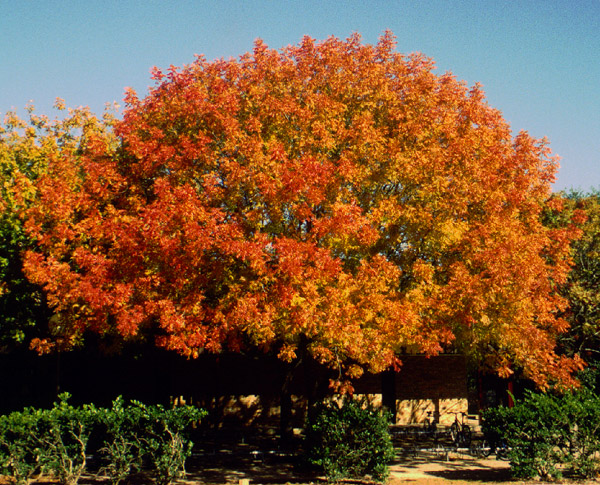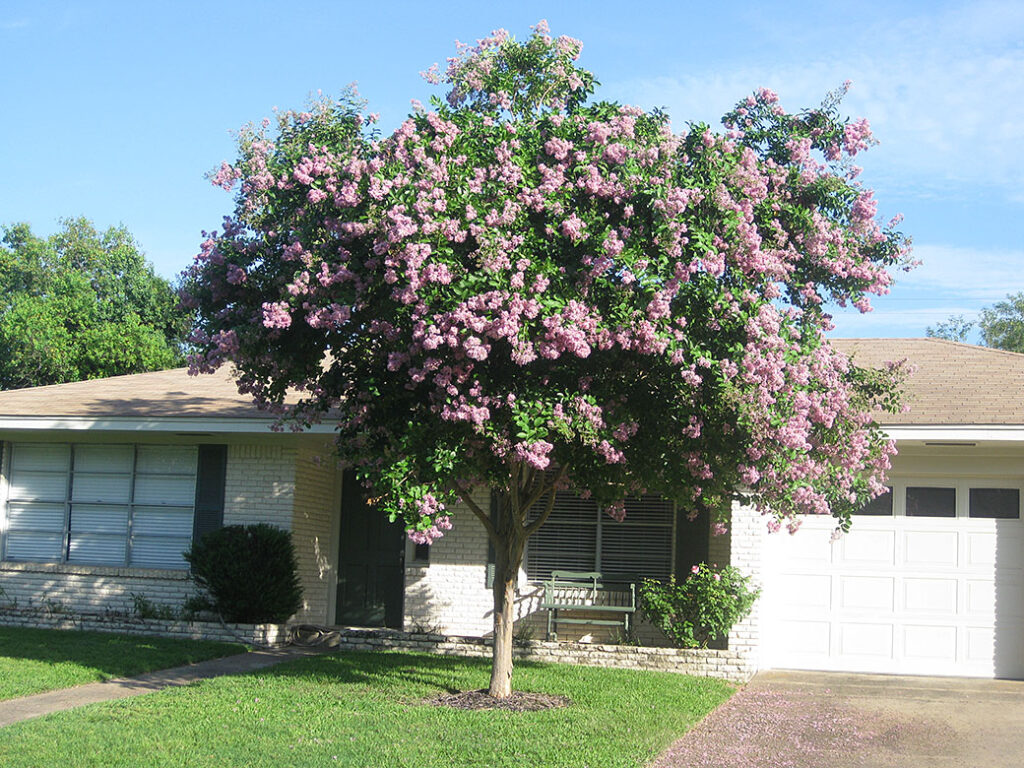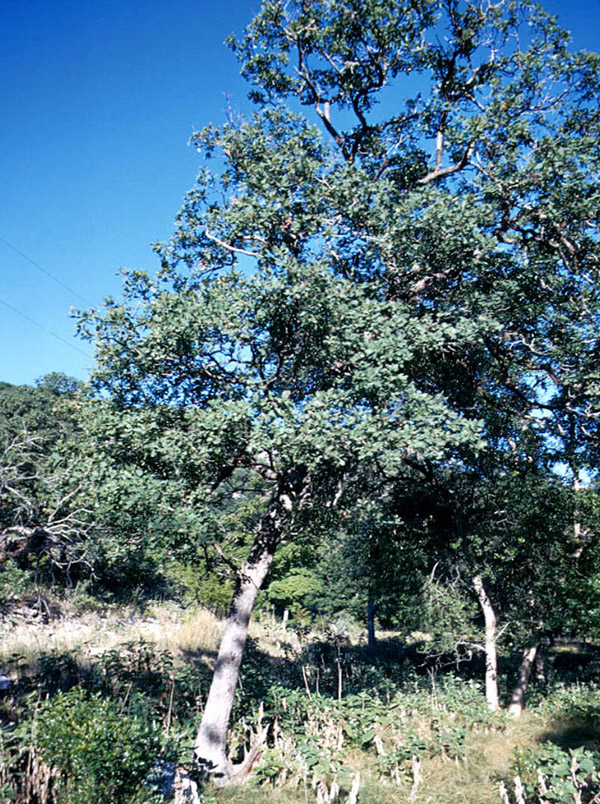Summary of the BCMG December Lunch & Learn meeting
By Shirley Conrad, BCMG
January 2023
Do you have questions on what, when, where, why, and how to plant trees? At the December Lunch and Learn at the Bexar County AgriLife Extension office, Marybeth Parsons, a Bexar County Master Gardener with advanced training on the subject, provided answers to those questions.
Marybeth began by defining a tree as a perennial plant typically with one trunk and usually a height of 15 feet or more and explained that the benefits of trees are numerous. They provide habitat for birds and wildlife, reduce storm water run-off and erosion, reduce energy consumption, provide wind and noise breaks, reduce the heat island effect in our communities, cool and/or warm the air, clean the air by filtering, improve human health, and add value to our homes.
Marybeth also discussed the parts of the tree, emphasizing the importance of many: that branches are independent off-shoots of the trunk that usually can be removed without harming the rest of the tree; that bark moderates the temperature inside the tree and decreases water loss; that leaves produce food for the tree through photosynthesis; that the roots anchor the tree, store food, and absorb water and nutrients from the soil; and that the tree’s canopy should be 2/3 of the total height of the tree.
In addition to understanding the importance of a tree’s parts, Marybeth stressed that it is essential to know the five basic functions of trees:
- Photosynthesis – process by which trees use sunlight, water, and carbon dioxide to create oxygen and energy.
- Respiration – process by which a tree takes in carbon dioxide and releases oxygen.
- Absorption – the primary job of the root system.
- Transpiration – the loss of water from leaves through evaporation.
- Translocation – the movement of water and nutrients from leaves to other parts of the tree where needed.
For the remainder of the presentation, Marybeth outlined the basics of tree care.
What tree should you plant? When selecting a tree consider the tree’s purpose, its mature size, any maintenance requirements and whether it is suitable for the south Texas environment. Trees grown in other areas of the country or even other areas of Texas may not grow well in this area. Marybeth stressed doing some research before purchasing and planting. She mentioned that CPS customers can apply for a $50 rebate in the form of a credit on their utility bill with the CPS Shade Tree Rebate program. CPS has over 35 approved tree varieties listed on the rebate application.
In a recent San Antonio Express News article, Calvin Finch recommended a few long-living, drought-tolerant and relatively pest-free varieties, such as the following: Texas red oak, cedar elm, Mexican sycamore, bur oak, Mexican white oak, chinkapin oak, and anaqua. He also mentioned that if your area is dominated by oaks and/or experiencing oak wilt infections, select one of the non-oak tree species. The Texas Superstar® website includes some trees such as the lacey oak, Chinese Pistache, and Basham’s Party Pink Crape myrtle, among others.



What should you look for when purchasing a tree? Most trees sold in garden centers in this area come in containers. Select a tree with no broken limbs, a healthy root system, no broken bark, a natural shape, and no roots growing out of the bottom of the container into the ground. She cautioned to avoid getting a tree that has girdling roots around the base of the trunk.
When should you plant trees? Fall is the best time to plant trees with winter being the second-best time. Early in spring can be okay but summer is not a good time to plant trees. The brutal heat is too stressful on the newly planted tree.
How do you plant a tree? Follow these guidelines for success:
- Remember to consider the mature height of the tree, mature spread of the root system, and the diameter of the trunk when selecting a location. Plant at least 10 feet but preferably 15 feet and more from buildings. Keep the tree away from sidewalks and driveways too. Check with your local utility companies before starting to dig!
- Construct a berm around the perimeter of the root system. This will provide protection from mechanical damage from lawnmowers and weed eaters. Fill the basin of the berm with water and allow the water to drain.
- Dig the hole slightly shallower and 2-3 times as wide as the root ball or container. The tree trunk root flare or root collar should be slightly above ground when planted.
- Never plant a dry plant in dry hole. Water both the tree and the hole before planting.
- Back fill the hole with native soil. There is no need for special soils and fertilizers. Fertilizing a newly planted tree can create stress and delay establishment.
- Apply 2 inches of hardwood mulch around the tree twice a year. Start at least 2 inches away from the base of the trunk and extend out about 3 feet all around the tree. Remember the 2-2-2- Rule: 2 inches of mulch twice a year (spring and fall) and at least 2 inches away from the trunk. If the mulch is up against the trunk, it traps moisture, can soften the trunk, and can provide easier access for insects and bacteria to enter the tree. Avoid those mulch cones, pyramids, or volcanoes!
- Lastly, remove all tags, strings, and stakes.
How often should trees be watered? Marybeth suggested using a long-shafted screwdriver (8-10”) to check the soil moisture. During year one, water the root system weekly at the drip line to a depth of 8-10”. During year two, water the root system monthly at the drip line to a depth of 8-10”. She cautioned that during the drought experienced this past year, just watering the lawn with the sprinkler is not enough water for new trees. Use that screwdriver to check the moisture of the soil. If there is no significant rainfall, maturing trees greater than 2 years old should be irrigated monthly.
In summary, choose the right tree for the right place, plant the tree properly, water sufficiently for proper development, and provide general maintenance to ensure success. Best of luck planting your next tree!
Be sure to attend the January 20, 2023, Lunch and Learn at noon to hear Dr. Larry Stein talk about Pecan trees.
All photos from Texas Superstar website
